The most magical month for Peruvians is approaching, and you can’t travel through the country without experiencing the Christmas traditions in Peru. This season is filled with warmth, family gatherings, and unique cultural expressions that make every celebration unforgettable. From the bustling streets of Lima to the Andes of Cusco and the lush Amazon rainforest, these festivities bring communities together with music, dances, traditional foods, and meaningful rituals.
In this article, we’ll explore the best of Christmas in Peru, from iconic foods like panetón and lechón to unique gifts, traditional music, and festive dances. You’ll also learn about regional customs, local legends, and how Peruvians celebrate this special season across the coast, highlands, and jungle. Keep reading to discover the heart of Peruvian Christmas and all the traditions that make it unforgettable.
Does Peru celebrate Christmas?
Yes, Peru certainly celebrates Christmas! It is a festive time of year filled with family gatherings, religious ceremonies, and traditional celebrations. On Christmas Eve, families come together for Nochebuena, enjoying a large meal, attending La Misa de Gallo (Midnight Mass), and exchanging gifts. Christmas in Peru is a beautiful blend of Catholic traditions and indigenous customs, celebrated with warmth, joy, and community spirit.
You might be interested: Festivals in Cusco month by month
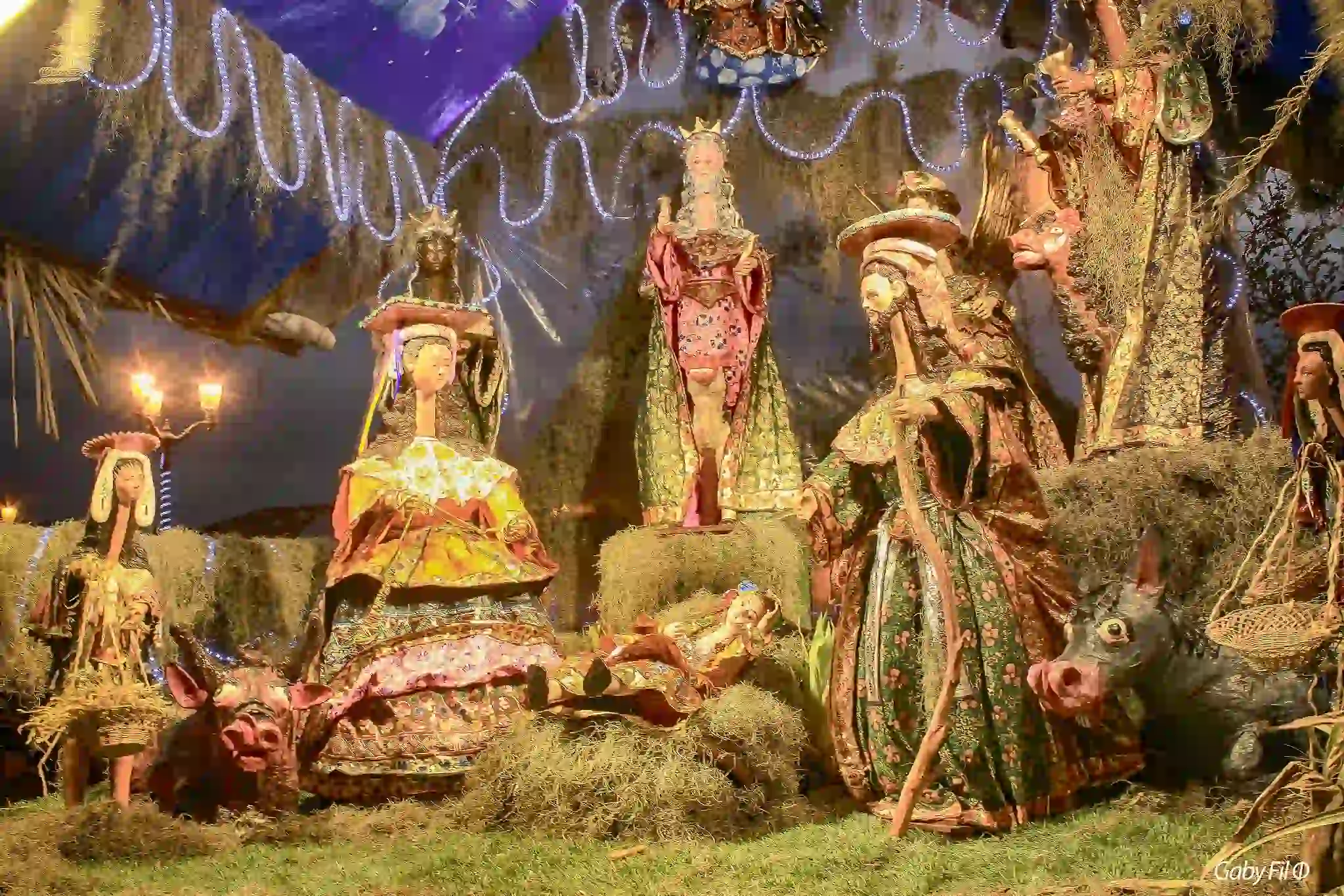
Giant Nativity scene in Cusco by Gaby
When is Christmas in Peru?
Christmas in Peru is celebrated on December 25th, just like in most parts of the world. However, the holiday season in Peru truly begins on December 24th, when families gather for Nochebuena (Christmas Eve) to enjoy a festive meal, attend La Misa de Gallo (Midnight Mass), and celebrate together. While Christmas Day itself is a more relaxed occasion, with many people spending time with family, the real excitement is often centered around the evening before.
Epiphany (La Bajada de Reyes) in Peru
Epiphany, celebrated every January 6th, marks the official end of the Christmas season in Peru with a religious festivity commemorating the visit of the Three Wise Men from the East to the Baby Jesus in Bethlehem. Although it’s not an official public holiday in the country, this Catholic tradition remains alive in many Peruvian families and communities, especially in Andean and rural areas where religious customs have deeper roots.
Peruvian weather at Christmas
In Peru, Christmas weather is very different from that of northern hemisphere countries, where snow covers the cities and temperatures drop below freezing. Being in the southern hemisphere, Christmas in Peru falls during the transition to summer, meaning the festivities are enjoyed with warmer, sunnier temperatures.
Weather on the Coast
In December, the Peruvian coast starts to experience warmer days. In cities like Lima, Arequipa, and Trujillo, temperatures can reach over 25°C, making it perfect for enjoying the beaches and outdoor activities. Although Lima can be a bit cloudy in the morning due to “garúa” (light mist), the weather is mild, and by midday, the sun shines brightly. Christmas on the coast is celebrated with clear skies and pleasant temperatures, ideal for outdoor holiday dinners.
Weather in the Highlands
In the highland areas, such as Cusco or Puno, the weather is cooler during the day, with temperatures around 18-20°C. While it’s not the heavy rainy season, light showers can occur in the mountains and valleys, especially in the afternoon. However, nights can be cold, so it’s recommended to bring warm clothing, as temperatures can drop significantly. Christmas here is celebrated in a quieter, cooler setting, perfect for enjoying local traditions, like the “Misa de Gallo” (Midnight Mass) and processions.
Weather in the Jungle
In the Peruvian jungle, December marks the start of the rainy season, so the weather is warm and humid. Daytime temperatures can exceed 30°C, and rain showers often come in the afternoons, providing some relief. The Amazon’s lush vegetation is at its peak, and Christmas here is celebrated amidst a vibrant, tropical landscape. While the weather can be hot and humid, the rain adds a unique touch to the festivities, creating a special atmosphere for Christmas celebrations.
You might be interested: 15 Traditional food in Peru
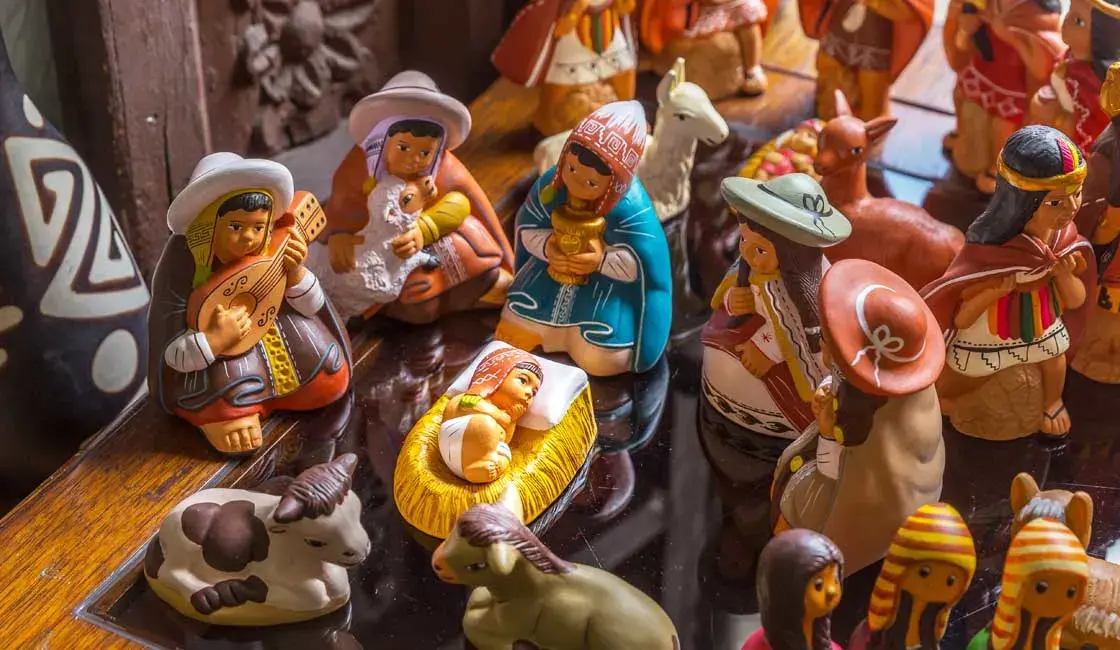
History of Christmas in Peru
The history of Christmas in Peru is a fascinating mix of indigenous traditions and Catholic influences. The celebration of Christmas was introduced by the Spanish during the 16th century, when they brought Catholicism to the region. With it came the customs of celebrating the birth of Jesus Christ, including Christmas Mass, nativity scenes, and festive meals. These traditions became central to the way Christmas was celebrated in Peru.
Catholic influence
In the early years of Spanish colonization, Christmas was firmly established as a religious holiday. Catholic Masses were held, and the nativity scene, or Nacimiento, became a central feature in homes and churches. These religious traditions spread throughout the country, particularly in major cities like Lima and Cusco. However, the strong presence of Andean culture began to shape the way Christmas was celebrated, blending Catholic rituals with local customs.
Fusion with Andean traditions
As time passed, Peruvian Christmas celebrations started to merge indigenous customs with Spanish Catholicism, creating a unique blend. For example, La Misa de Gallo (Midnight Mass) became a key part of Christmas, but it was often accompanied by traditional Andean music and dance. In the highland regions, Christmas is celebrated with processions and dances that combine Christian and indigenous elements, symbolizing the harmony between the two cultures.
You might be interested: 40 Animals in the peruvian amazon
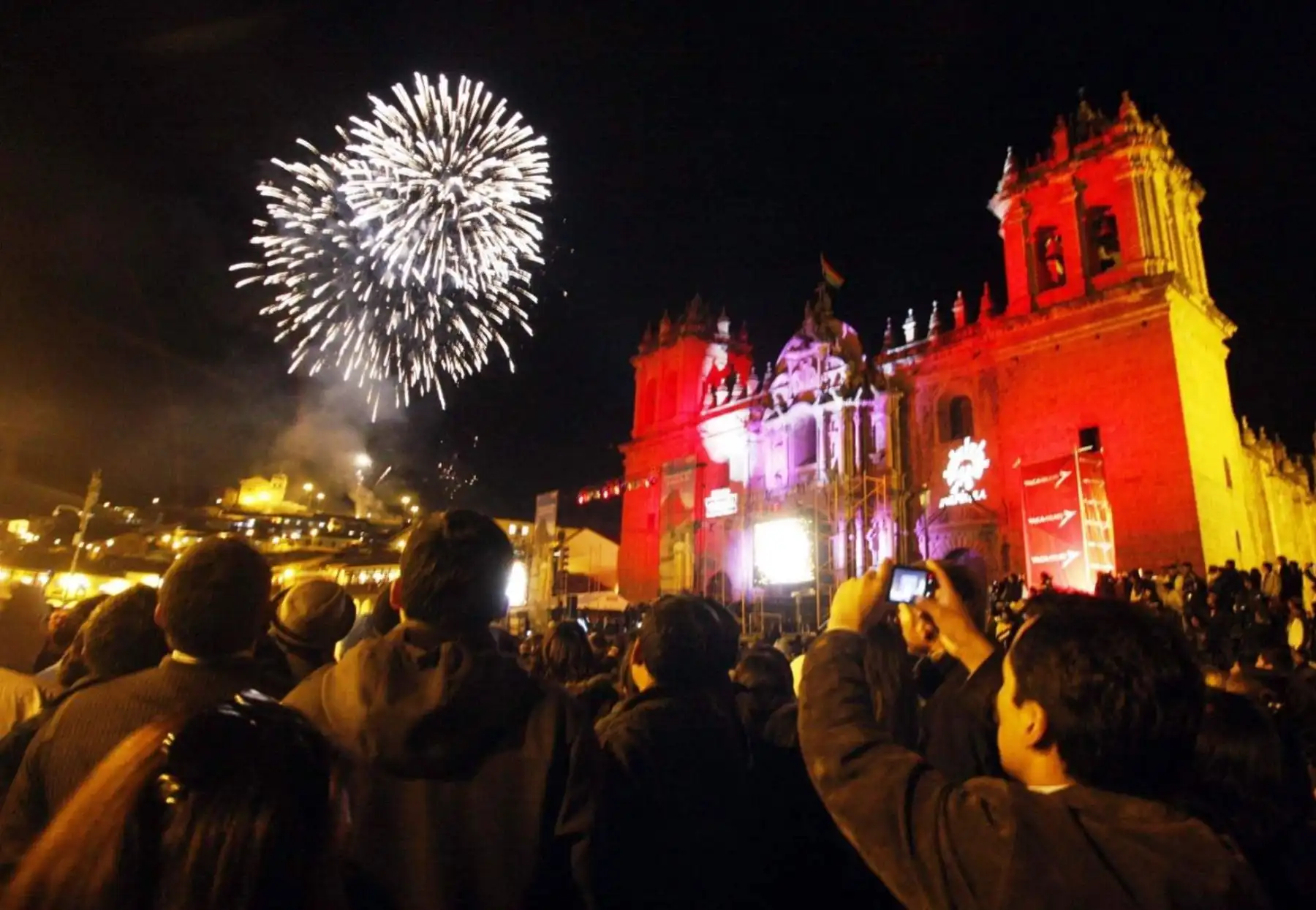
Christmas traditions in Peru
Christmas in Peru is a beautiful fusion of indigenous traditions and Catholic influences, reflecting the country’s diverse culture and history. The holiday season is celebrated with joy and warmth, bringing families together for festive meals, religious ceremonies, and unique cultural expressions. One of the most beloved traditions during Christmas is La Bajada de Reyes (the Arrival of the Three Kings) on January 6th, especially in the Andean regions. This tradition involves a festive procession where children dress up as the three kings and offer gifts to the community. While Christmas is a deeply religious occasion, the celebrations vary across regions, showcasing Peru’s rich Christmas Traditions in Peru, from the highlands to the coast, and even the Amazon.
Christmas traditions on the Coast
In the coastal regions of Peru, particularly in Lima, Christmas celebrations blend religious devotion with vibrant festivities. The highlight of the holiday season is La Misa de Gallo (Rooster’s Mass), held on Christmas Eve at midnight. Families attend this mass before returning home for a festive meal that often includes pavo (turkey), panetón (Christmas fruitcake), and chocolate caliente (hot chocolate).
The traditional Nacimiento (nativity scene) is widely displayed, often larger than life, with figures representing the nativity story, along with indigenous and local Peruvian elements such as llamas and Andean mountains. Families also gather to exchange gifts and enjoy the colorful fuegos artificiales (fireworks) that light up the sky. Coastal Peruvians celebrate the 12 grapes tradition, eating one grape for each chime of the clock at midnight to ensure good luck for each month of the new year.
Christmas traditions on the Andes
In the Andes, Christmas takes on a more spiritual tone, combining Catholic and Andean rituals. In rural areas, La Misa de Gallo is also celebrated, but the celebrations are marked by the presence of Andean music—flutes, charangos, and drums are common during the processions. After mass, families gather for a festive meal, often including cuy (guinea pig) or tamales (a typical dish made of corn dough wrapped in leaves).
The pascua andina (Andean Christmas) is also characterized by traditional dances, such as the Huayno, a lively folk dance that is often performed in the town squares. The Nacimiento in the highlands may feature local scenes and animals, such as alpacas and vicuñas, instead of the traditional European figures. In some remote Andean communities, Pachamama (the Earth goddess) is honored alongside the birth of Christ, symbolizing the connection between religion and the land.
Christmas traditions on the Peruvian Amazon
In the Peruvian Amazon, Christmas takes on a more indigenous and ecological dimension, with traditions that focus on community and the natural world. While the Misa de Gallo is also celebrated in the jungle, it is often combined with local rituals that honor nature. People in the Amazon celebrate with typical dishes such as juanes (rice and meat wrapped in banana leaves), tacacho con cecina (fried plantains with dried meat), and pescado (fish).
In some communities, planting trees or offering gifts to the rivers is a symbol of gratitude to the Earth and a way to promote environmental preservation. The Nacimiento in Amazonian homes is often decorated with local materials like palm leaves and wooden figurines representing local wildlife. The use of candles and firelight adds a magical, ethereal touch to the celebrations in the jungle, where the holiday spirit blends with the surrounding nature.

The best places for Christmas traditions in Peru
Christmas in Peru is celebrated with rich traditions across the country, and there are several places where these festive customs are especially vibrant. Here are some of the best places to experience Christmas traditions in Peru:
Cusco
As the heart of Peruvian culture, Cusco’s Christmas celebrations are full of warmth and spirituality. The Nacimiento (nativity scene) is elaborately displayed in homes and public spaces. The Misa de Gallo (Midnight Mass) at the Cathedral is a significant event, and the streets come alive with traditional music, dances, and festivals.
Lima
In Lima, Christmas is celebrated with festive decorations, light displays, and Christmas markets. The capital city hosts an array of events, from processions to concerts. The historic Plaza Mayor is beautifully lit, and many churches hold midnight Mass, which is a cherished tradition.
Arequipa
Arequipa celebrates Christmas with a unique blend of Andean traditions and Catholic practices. The city’s churches are beautifully decorated, and the Misa de Gallo is a highlight. The nearby Colca Valley also hosts smaller, more intimate celebrations, with communities coming together for local festivals.
Puno
On the shores of Lake Titicaca, Puno celebrates Christmas with a strong Andean influence. Traditional dances and music are part of the celebrations, and retablos (handcrafted nativity scenes) are displayed in many homes, reflecting the fusion of Catholic and indigenous traditions.
Iquitos
In the Amazon region, Christmas is a tropical affair. In Iquitos, you’ll find vibrant Christmas celebrations with a mix of Catholic and indigenous influences. Traditional music, dances, and feasts are central to the holiday festivities, and families come together to celebrate in the lush Amazonian environment.
Pisco
Known for producing Peru’s famous brandy, Pisco is a wonderful place to experience Christmas traditions, especially in the form of local festivities and gatherings. Traditional foods and drinks like panetón and pisco sour are enjoyed, and the town is beautifully lit for the season.
You might be interested: Summer in Peru: 5 top destinations to visit
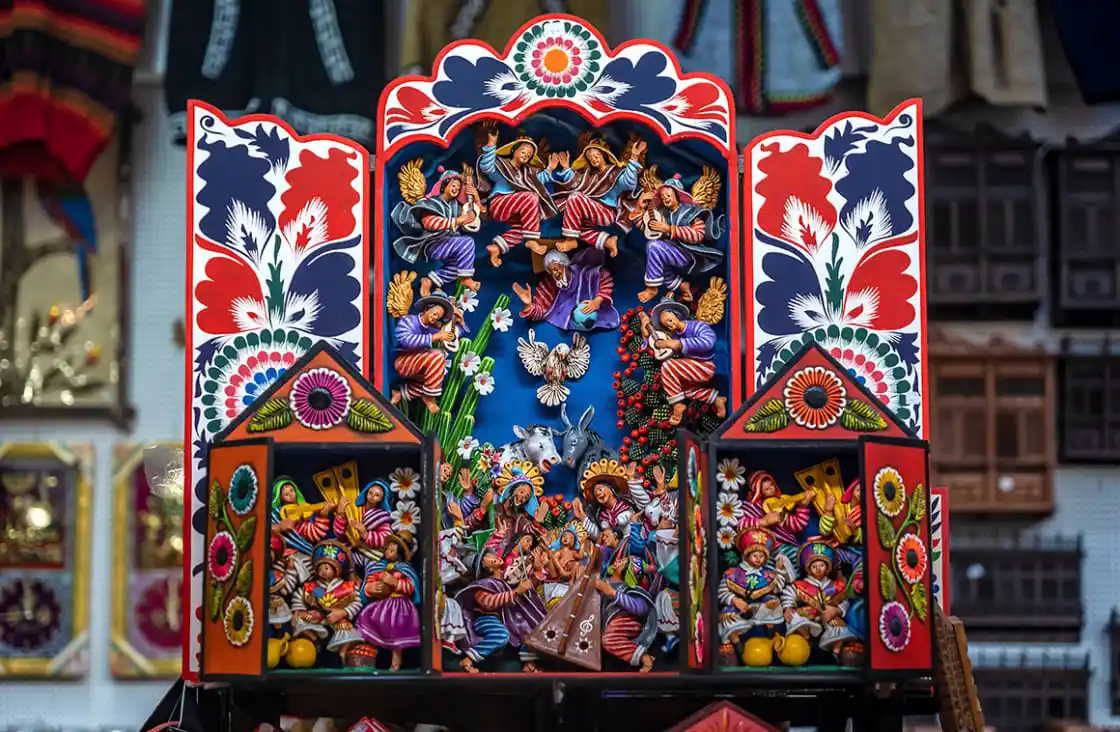
Unique Christmas gifts from Peru
Looking for a unique Christmas gift that captures the essence of Peru? The country offers a wide range of handmade and traditional items that make for unforgettable presents.
- Retablos: Colorful wooden boxes depicting religious scenes, folklore, or daily life, commonly found in markets like those in Cusco and Pisac.
- Peruvian Textiles: Handwoven scarves, blankets, and ponchos made from alpaca and baby alpaca wool, available in artisan markets in Cusco, Arequipa, and San Pedro Market.
- Ceramic Pottery: Beautifully crafted pottery featuring traditional Andean designs, often sold in Pisac Market and artisan shops in the Sacred Valley.
- Silver Jewelry: Intricate pieces inspired by Inca culture, frequently found in jewelry shops in Cusco and Arequipa or local markets.
- Peruvian Chocolate: Rich, artisanal chocolate made from fine Peruvian cocoa beans, widely available in specialty chocolate shops in Lima and Cusco.
- Handmade Wool Rugs: Vibrant, handwoven rugs made from alpaca wool, typically sold in markets in Cusco and textile shops in Arequipa.
- Inca-inspired Crafts: Jewelry, figurines, and home décor reflecting ancient Incan symbols, often found in local markets in Cusco and the Sacred Valley.
- Pisco: Peru’s famous brandy, often sold in decorative bottles, available in liquor stores and artisan shops throughout the country.
You might be interested: All about the Peruvian Amazon tribes
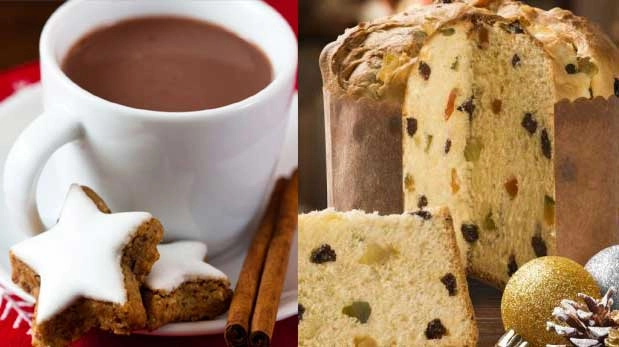
Traditional peruvian christmas food
The culinary Christmas Traditions in Peru and New Year in Peru represent a delicious fusion of indigenous Andean ingredients, Spanish colonial influences, and immigrant contributions that have been perfected over generations. From the iconic Italian panetón that has become more Peruvian than anywhere else in the world, to pre-Columbian beverages like chicha morada, these festive foods and drinks bring families together and mark the most important celebrations of the year.
1. Panetón
This sweet bread studded with dried and candied fruits arrived in Peru with Italian immigrants around 1900 and has been completely adopted as the country’s own. Peru is now the second-largest producer and consumer of panettone in the world, with beloved local brands like D’Onofrio, Todinno, and Gloria dominating stores from November through January. No Peruvian Christmas is complete without panetón, traditionally served with hot chocolate, and many families enjoy it for breakfast throughout the entire holiday season.
Lechón al Horno (Roast Suckling Pig)
This spectacular centerpiece features a whole suckling pig marinated overnight with garlic, cumin, chicha de jora, and local spices, then slow-roasted for hours until the skin becomes crackling crispy. The preparation often begins before dawn on Christmas Day in outdoor brick ovens, filling neighborhoods with its mouthwatering aroma. Traditionally served with tamales or arroz árabe, lechón represents celebration and abundance, reserved for the most important family gatherings.
2. Pavo a la Peruana (Peruvian-Style Turkey)
Peru’s unique turkey features a bold marinade of orange juice, pisco, ají amarillo, garlic, and cumin that infuses the meat with distinctly Peruvian flavors. The stuffing includes dried fruits, nuts, raisins, and sometimes quinoa, creating a sweet-savory combination. Introduced more widely in the mid-20th century, turkey has become increasingly popular as an alternative to lechón, though the Peruvian preparation methods remain distinctly local.
3. Tamales
These substantial parcels of seasoned corn masa wrapped in banana leaves are a Christmas staple, differing from Mexican versions in size and flavor. The masa is enriched with ají panca, lard, and chicken stock, with fillings varying by region – coastal versions feature chicken or pork with olives and hard-boiled egg, while highland versions might include alpaca or lamb. Making tamales is traditionally a communal family activity on December 23rd or 24th, with multiple generations gathering to prepare dozens together.
4. Sopa de Navidad (Christmas Soup)
This hearty soup serves as the Christmas Traditions in Peru dinner starter, featuring rich broth from hours of simmering chicken and pork bones, enriched with tender meat, rice or noodles, and vegetables. Regional variations include barley or quinoa in highland versions, while coastal preparations tend to be lighter. Seasoned with fresh herbs and served piping hot despite Peru’s summer Christmas, this soup connects families to their ancestors and represents the warmth of gathering together.
5. Chocolatada (Thick Peruvian Hot Chocolate)
Peruvian hot chocolate is a rich, thick beverage made from melted chocolate tablets, whole milk, sugar, cinnamon, and cloves. Despite Christmas falling during Peru’s hot summer, drinking steaming hot chocolate remains non-negotiable, with the ritual of dunking panetón slices considered essential. Throughout December, communities organize “chocolatadas” where enormous pots are distributed to disadvantaged neighborhoods, making this beverage a symbol of solidarity and generosity.
6. Rompope
This luxurious Peruvian eggnog combines egg yolks, condensed milk, evaporated milk, sugar, and pisco, flavored with vanilla, cinnamon, and nutmeg. Many families guard their specific recipe as closely-held secrets, with some adding port wine for extra complexity. Served in small glasses as an after-dinner digestif during Christmas and New Year, rompope represents sophistication and festivity, offering the perfect ending to heavy holiday meals.
7. Chicha Morada
This vibrant purple beverage is made by boiling dried purple corn with pineapple, apple, quince, cinnamon, and cloves, then sweetening with sugar and lime juice. The stunning color comes from anthocyanins in the purple corn, connecting this drink to Peru’s pre-Columbian heritage. While enjoyed year-round, it takes on special significance during holidays when families prepare large batches to serve cold alongside heavy festive foods, offering a refreshing non-alcoholic option.
The story of the “Boy with the Thorn” in Cusco
The story of the Boy with the Thorn is associated with a highly venerated sculpture in Cusco, Peru. This sculpture represents the Child Jesus, known locally as Manuelito, and has profound significance in Christmas traditions in Peru.
According to legend, Manuelito, a boy from the region, was playing barefoot when he pricked his foot on a thorn. Seeing his pain, the Virgin Mary removed the thorn, healing his wound. From that moment on, she has been credited with miracles and graces for those who ask for her intercession. This story has become a very significant tradition in Cusco, especially during Christmas, as it symbolizes suffering, compassion, and healing.
You might be interested: Peru in october 2025

Traditional Peruvian Christmas music
Peruvian Christmas music is a delightful blend of Spanish and Andean influences, and it’s an essential part of the holiday celebrations. During Christmas, you can hear a wide variety of traditional songs and dances that reflect the country’s cultural diversity. Here are some of the classic styles and songs you’ll find during the season:
Villancicos (Christmas Carols)
The villancicos are traditional Spanish Christmas carols that have been embraced throughout Peru. These carols are sung in churches and homes during the Christmas season, often with heartfelt renditions of Noche de Paz (Silent Night) and Los Peces en el Río (The Fish in the River), a popular Christmas carol in Peru.
Huayno
One of the most iconic styles of music in the Andean regions of Peru is huayno, a lively and festive genre. During Christmas, huayno songs are often performed in the highlands, with lyrics celebrating the season and honoring the birth of Jesus. Traditional instruments like the charango (a small string instrument) and panpipes are commonly used, creating a joyful and community-centered atmosphere.
Cajón Music
The cajón, a box-shaped percussion instrument, is commonly used in festive music in coastal regions, especially in the Afro-Peruvian communities. While it’s typically associated with cumbia and festejo, during Christmas it accompanies villancicos and other celebratory tunes, giving a distinct rhythm to the festivities.
La Danza de las Tijeras (Dance of the Scissors)
Is a Christmas Traditions in Peru and Andean dance, La Danza de las Tijeras is sometimes performed during Christmas celebrations in the highlands. Dancers use scissors (tijeras) as props, and the performance is accompanied by the rhythmic beat of huayno music, adding a festive and energetic element to the celebrations.
Wishing Merry Christmas the Peruvian style
In Peru, Christmas greetings are filled with warmth and joy. On Christmas Eve, people commonly say “¡Feliz Noche Buena!” as families gather for a festive dinner, followed by Midnight Mass. On Christmas Day, the greeting changes to “¡Feliz Navidad!” as everyone shares in the celebration. These simple, heartfelt wishes reflect the spirit of togetherness that defines Christmas in Peru.



